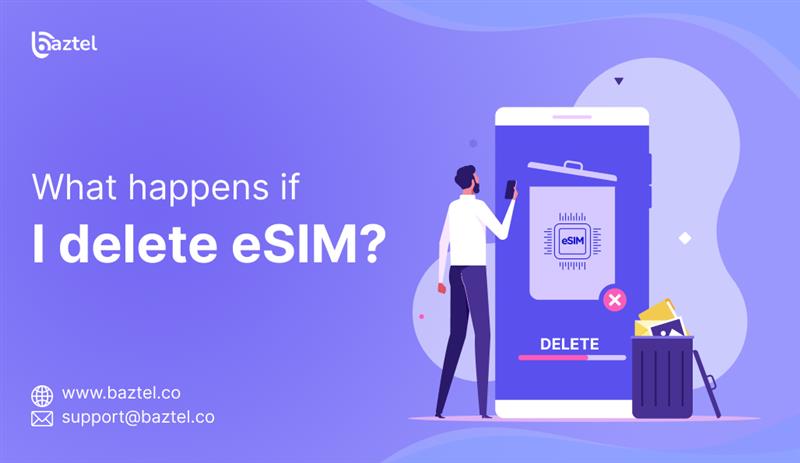As mobile technology develops, eSIM (embedded SIM) quickly replaces traditional physical SIM cards. Unlike regular SIMs, which should be inserted into a phone, an eSIM is made in the device itself and can be digitally activated, usually by scanning a QR code or using a carrier app. This makes the carrier easy to manage, manage multiple profiles (for example, for work and a trip), and keep the contact globally without the exchange of the SIM card.
But what happens if I delete eSIM accidentally or intentionally? Will your phone stop working? Can you get it back? Is your data safe?
In this blog, we will find out what happens if I delete eSIM, what can be restored, and what precautions you should take before removing it. Whether you prevent connection problems or change equipment, it is necessary to understand the results.
What Happens If I Delete eSIM?
If you are wondering what happens if “I remove eSIM from my phone,” the answer is not as simple as removing a file or turning off the setting. Removing eSIM directly affects your mobile connection and, in some cases, your access to transport services. Let’s break every aspect in detail:
1. Immediate Effects
When you delete an eSIM, you’re not just removing a digital file. You are removing the mobile subscription profile that allows your device to connect to your carrier’s cellular network. This profile contains key configuration details, such as
- Your mobile number
- Access credentials to connect to the cellular network
- Subscription data like plan type and network settings
Learn more about how eSIM technology works
So what happens immediately?
- Your phone will stop connecting to the mobile network associated with that eSIM.
- You’ll lose the ability to make or receive phone calls, send text messages (SMS), or use mobile data.
- If your eSIM was the only mobile line on your phone, your phone would effectively behave like a Wi-Fi–only device.
Think of it as removing the SIM card from the traditional phone, except it’s digital, and it requires no physical action. The moment you confirm the deletion, the mobile provider’s link is broken for that line.
2. Impact on Mobile Connectivity
The effect of deleting an eSIM depends on how you use your device:
If It Was Your Primary SIM:
- You will not be able to call even for emergencies (unless Wi-Fi call is activated and available).
Mobile data will be cut, so no apps or services dependent on cell data (e.g., maps, WhatsApp, email, browser) will work until you are on Wi-Fi.
You will also lose access to SMS and MMS, which are often crucial to bank OTP, two-factor authentication, or communication with those who do not use internet-based messages. - This clearly shows what happens if I delete eSIM—it disrupts essential services that many users rely on daily. Being aware of what happens if I delete eSIM can help you prepare before making any changes.
If You Had a Dual SIM Setup:
- If the deleted eSIM was one of two SIMs on the phone, your secondary SIM may still work. However, you’ll lose all services tied to the deleted line.
- For example, if the eSIM was for international roaming and your physical SIM is for local use, you’ll lose access to the roaming network.
Apple’s official guide to managing eSIM on iPhones
Roaming Services Disappear Too:
- If you traveled and used an eSIM for data abroad, the removal of the cutting access to international roaming will potentially leave you without mobile internet before Wi-Fi is available.
In short: You lose voice, text, and data capabilities linked to that specific eSIM profile.
3. Loss of Data or Plan
A deleted eSIM can result in the permanent loss of your mobile plan—or at least the data associated with it—depending on how your carrier handles deletions.
What You Might Lose:
- Remaining mobile data Balance: If you had unused data, it can be confiscated by your carrier’s eSIM without changing plan status.
- Prepaid balance or credit: They are often tied to eSIM profiles and cannot move to a new one before contacting the carrier.
- Your mobile number (temporary or permanent): If the deletion is considered canceled, your number can be appointed if you work quickly.
Two Common Scenarios:
- Re-downloadable eSIMs (like from Airalo, BazTel, or Nomad):
- Some carriers or eSIM suppliers allow you to recognize the same eSIM using your account board or by scanning the original QR code again.
- In this case, you may restore your plan, number, and data – but only when it is not finished or has been inactivated by the carrier.
- One-time-use eSIMs (common in international travel or prepaid plans):
- These are often not reusable. Once deleted, you’ll need to purchase a new eSIM profile.
- Any remaining data or validity is lost.
Important: Some providers treat deletion as cancellation, meaning your entire plan is voided immediately.
Can You Recover a Deleted eSIM?
Yes, in many cases you can restore a deleted eSIM, but you can do it; it depends completely on your mobile carrier, the type of eSIM scheme you used, and how the delay was handled. While some suppliers simplify the process, other people may consider the deletion to be final and irreversible.
Let’s break down the different scenarios in which recovery is possible and where it might not be.
Re-downloading from Carrier
Most mainstream mobile carriers and iconic eSIM suppliers (such as Airalo, BazTel, Holafly, and Nomad) provide the opportunity to rebuild the eSIMs after users are removed. This is especially useful in cases where the deletion was random or you switch to the equipment.
Here’s how the re-download process typically works:
- Step 1: Log in to your account through the carrier’s website or app.
- Step 2: Go to settings or manage the plan.
- Step 3: Look for an option like “Download again.”
- Step 4: You will receive a new QR code or activation code.
- Step 5: Open the eSIM setup on your phone and scan the new QR code or enter the activation details.
Most carriers let you do this for free once or twice. However, some suppliers may limit the number of eSIMs to be loaded again, especially for prepaid or travel-specific arrangements.
Limitations and Exceptions
Although recovery is possible in many situations, there are important limitations you need to be aware of.
- One-time-use QR codes: Some travel eSIMs, especially short-term or prepaid data plans, come with a one-time-use QR code. Once the eSIM is deleted, that code cannot be reused. In this case, you’ll need to purchase a new plan.
- Permanent cancellation: Certain carriers treat eSIM deletion as a formal cancellation of the service. This may lead to the plan being terminated entirely and your number potentially being reassigned.
- Download expiry: In some cases, eSIM profiles come with an expiration date. For example, you may be required to activate the eSIM within 30 days of purchase. If you delete it after that window, reactivation may no longer be possible.
Always check your provider’s terms and policies before deleting an eSIM to avoid losing access.
When to Contact Customer Support
There are also situations where you cannot re-download the eSIM yourself and need assistance from customer support. Reach out to your provider if:
- You can’t log in to your account
- Your account is closed or suspended
- A real alternative again is unavailable
- Need to travel while traveling or instant connection
When contacting support, you must be prepared to provide account information (email or phone number), device details, and possibly a copy of the original purchase receipt or transaction ID.
The support team can usually confirm your identity and issue a new eSIM QR code or activation link. In some cases, they may have to neutralize their previous eSIMs from far away to do new things first.
Does Deleting eSIM Cancel Your Mobile Plan?
This is a common concern, and the answer depends on your carrier’s policies.
1. Difference Between Deleting and Deactivating
- Deleting an eSIM from your device removes the profile from your phone—but does not always cancel the plan.
- The plan may still remain active in your carrier account unless explicitly canceled.
2. Carrier-Specific Rules
Each carrier handles this differently:
- Some treat deletion as temporary (can re-download)
- Others view it as permanent (new eSIM required)
- Few may suspend your account if not used for a while
Always check your carrier’s terms before deleting.
Situations Where Deleting an eSIM Might Be Necessary
Although deleting an eSIM seems risky, there are valid reasons to do it:
1. Switching Phones
If you’re moving to a new device:
- You might need to delete the eSIM from the old phone
- Then re-download it to the new one (if your carrier allows)
2. Troubleshooting Connectivity Issues
Sometimes, deleting and reinstalling an eSIM resolves:
- Network connection problems
- Profile errors
- Carrier app bugs
3. Freeing Up eSIM Slots
Most devices only support a limited number of eSIM profiles (e.g., 5–8 stored, but only 1–2 active at once). Deleting old or unused profiles helps free up space.
Precautions Before Deleting an eSIM
Before you hit that “Remove eSIM” button, take these steps:
1. Backing Up Important Details
- Take a screenshot or write down:
- Carrier name
- Plan type
- Customer ID/account number
- Back up your contacts and messages (if stored on eSIM/carrier cloud)
2. Checking Carrier Policies
Some important questions to ask:
- Will deleting eSIM cancel my plan?
- Can I re-download the eSIM later?
- Is there a charge to issue a new eSIM?
3. Verifying You Can Re-download
Before deleting, make sure:
- Your account is active
- You still have the original QR code
- You can log in to your carrier’s portal or app
How to Safely Remove or Delete an eSIM
If you’re sure you want to proceed, follow these steps:
Step-by-Step Guide for iPhone:
- Go to Settings > Cellular (or Mobile Data)
- Tap on the eSIM plan you want to delete
- Choose Remove Cellular Plan
- Confirm the action
Step-by-Step Guide for Android:
- Go to Settings > Network & Internet > SIMs
- Select the eSIM profile
- Tap on Delete or Remove
- Confirm deletion
What to Do After Deletion:
- Reboot your phone
- If replacing the eSIM, install the new profile immediately
- If not, ensure Wi-Fi is connected for continued internet access
FAQs
1. Can I reinstall the same eSIM later?
It depends on your carrier. Some people allow the loads again, while others limit it to disposable use. Always check first.
2. What happens to my contacts and messages?
If your contacts and messages were collected:
- On your device: No effect
- On eSIM or cloud: you can lose access until you join again
3. Is it accused of recovering a deleted eSIM?
Some carriers in particular charge a small rear cycle or issuance fee for international or computer-level schemes. Others provide free basic breezes through their apps or sites.
4. Can I use the same eSIM QR code again?
Sometimes yes, but not always. Many QR codes quit after first use or after a certain time.
5. If I remove eSIM, will I lose my number?
Removing eSIM does not mean losing your number; your number is tied to your transport account and not eSIM.
Conclusion
Deleting an eSIM from your device means you will immediately lose your mobile connection for a specific plan, including calls, texts, data, and roaming services. This can be impractical, especially if the eSIM was your primary or only connection to mobile networks. What happens if I delete eSIM largely depends on the carrier’s guidelines and the type of eSIM you are using—whether your plan has been permanently canceled or can be restored.
Some carriers allow you to rebuild the same eSIM with a new QR code or activation link, especially if you just switch or fail the equipment. However, other deletions are considered as a complete cancellation, especially with prepaid or a time-to-go-hitting eSIM. In these cases, it cannot be possible without contacting the support behind or without buying a new plan.
Key Takeaways:
- Deleting an eSIM removes access to that mobile plan.
- Some eSIMs are recoverable; others are not.
- Always check with your carrier before deleting.
- Backup details and QR codes before making changes.
Understanding what happens if you remove eSIM, then you avoid surprise and keep in touch whether at home or abroad. Take care, follow the guidelines for the carrier, and only make changes when necessary to keep you under the control of your digital connection.
Blog Author
Peter
Peter started BazTel.co to make mobile internet easier for travellers. He noticed how tough it was to find good network options while visiting new countries. That’s when he built BazTel — a place where anyone can buy eSIMs online without confusion or long steps. He believes tech should be simple and useful, not complicated. When he’s free, he likes to travel, test BazTel himself, and keep improving it based on real user problems.

 Botswana
Botswana Zambia
Zambia Congo
Congo Colombia
Colombia China mainland
China mainland Chile
Chile Chad
Chad Central African Republic
Central African Republic Canada
Canada Cameroon
Cameroon Cambodia
Cambodia Burkina Faso
Burkina Faso Bulgaria
Bulgaria Brunei Darussalam
Brunei Darussalam Brazil
Brazil Aland Islands
Aland Islands Bosnia and Herzegovina
Bosnia and Herzegovina Bolivia
Bolivia Belgium
Belgium Belarus
Belarus Bangladesh
Bangladesh Bahrain
Bahrain Azerbaijan
Azerbaijan Austria
Austria Australia
Australia Armenia
Armenia Argentina
Argentina Algeria
Algeria



